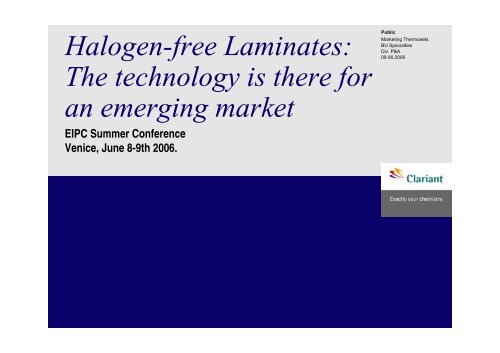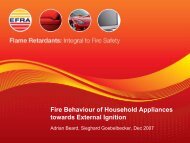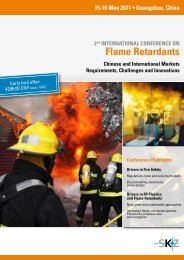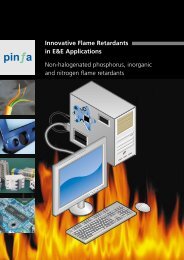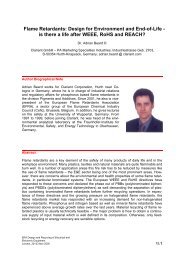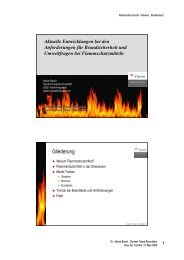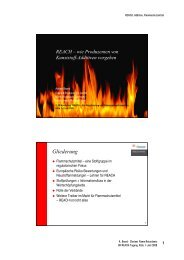Halogen-free Laminates - Flame Retardants-Online
Halogen-free Laminates - Flame Retardants-Online
Halogen-free Laminates - Flame Retardants-Online
You also want an ePaper? Increase the reach of your titles
YUMPU automatically turns print PDFs into web optimized ePapers that Google loves.
<strong>Halogen</strong>-<strong>free</strong> <strong>Laminates</strong>:<br />
The technology is there for<br />
an emerging market<br />
Public<br />
Marketing Thermosets<br />
BU Specialties<br />
Div. P&A<br />
09.06.2006<br />
EIPC Summer Conference<br />
Venice, June 8-9th 2006.
Outline<br />
• Regional importance of commercial halogen <strong>free</strong> materials<br />
• Recent activities about “halogen <strong>free</strong>”<br />
• What are “halogen-<strong>free</strong>” flame retardants?<br />
• Technical requirements to FR system<br />
• Review of halogen-<strong>free</strong> FR system for base materials<br />
• Review of halogen-<strong>free</strong> resin chemistries<br />
• Overview of commercially available X-<strong>free</strong> CCL<br />
• Summary<br />
<strong>Halogen</strong>-<strong>free</strong> <strong>Laminates</strong>:<br />
The technology is there for<br />
an emerging market<br />
Public<br />
Marketing Thermosets<br />
BU Specialties<br />
Div. P&A<br />
09.06.2006<br />
Slide 2
Regional importance of commercial<br />
halogen <strong>free</strong> materials<br />
• “Green electronics” are currently limited to Consumer Electronics<br />
items e.g. TV-Sets, DVD-Player, Personal Computers etc.<br />
• Automotive OEM interested in, but no innovation pull, would rather<br />
switch once technology is mature.<br />
• Although Consumer Electronics are global markets, strong<br />
differences can be observed:<br />
<strong>Halogen</strong>-<strong>free</strong> <strong>Laminates</strong>:<br />
The technology is there for<br />
an emerging market<br />
Public<br />
Marketing Thermosets<br />
BU Specialties<br />
Div. P&A<br />
09.06.2006<br />
Slide 3<br />
- Japan: >15% halogen-<strong>free</strong> base materials (growing)<br />
- Europe: 3-5% (stable)<br />
- USA: 6% (driven by export)<br />
- Korea: no data available, but probably a few%
Recent activities about “halogen <strong>free</strong>”<br />
• US EPA: toxicological and environmental assessment of TBBP-A<br />
and non halogenated alternatives (started 2006)<br />
- identify and characterize <strong>Flame</strong> retardants<br />
- from their environmental, health and safety fate aspects<br />
- focus on areas of life cycle with greatest exposure (e.g. chemical<br />
exposure during manufacture, accidental fires, disposal, landfill,<br />
recycling)<br />
- include “commercially available FRs”, but will not exclude those<br />
limited due to their current cost position.<br />
<strong>Halogen</strong>-<strong>free</strong> <strong>Laminates</strong>:<br />
The technology is there for<br />
an emerging market<br />
Public<br />
Marketing Thermosets<br />
BU Specialties<br />
Div. P&A<br />
09.06.2006<br />
Slide 4<br />
Interested parties may contact: Vokes.Kathleen@epa.gov
Recent activities about “halogen <strong>free</strong>”<br />
• Industry consortium iNEMI: “<strong>Halogen</strong>-<strong>free</strong> initiative”<br />
- aims to promote standards and test guidelines for halogen-<strong>free</strong><br />
materials, based on the requirements of the different market<br />
segments and their technical, commercial and functional viability<br />
- will exclude toxicological & environmental aspects, as dealt within<br />
EPA study.<br />
Contact bpfahl@nemi.org or mark_d_newton@dell.com<br />
<strong>Halogen</strong>-<strong>free</strong> <strong>Laminates</strong>:<br />
The technology is there for<br />
an emerging market<br />
Public<br />
Marketing Thermosets<br />
BU Specialties<br />
Div. P&A<br />
09.06.2006<br />
Slide 5<br />
• High Density Packaging User Group (HdPUG)<br />
- Update of the report on environmental assessment of halogen-<strong>free</strong><br />
PWB (phase II report dated January 2004)<br />
Contact: ruben.bergman@hdpug.se or fonga@ibm.com
Recent activities about “halogen <strong>free</strong>”<br />
• These activities are motivated by:<br />
- business opportunities<br />
The development of the halogen-<strong>free</strong> market is no longer linked to<br />
potential restrictions on TBBP-A. but is driven by its own dynamic<br />
(market demand). Driving forces are OEM´s requirements as well<br />
as Green Procurement (ecolabels to a lesser degree)<br />
- the necessity to update past knowledge on “halogen-<strong>free</strong>”, due to<br />
further technical improvements (materials of 2nd or 3rd generation)<br />
and the multiplication of commercially available materials<br />
<strong>Halogen</strong>-<strong>free</strong> <strong>Laminates</strong>:<br />
The technology is there for<br />
an emerging market<br />
Public<br />
Marketing Thermosets<br />
BU Specialties<br />
Div. P&A<br />
09.06.2006<br />
Slide 6
What are “halogen-<strong>free</strong>” materials?<br />
• The term “halogen-<strong>free</strong>” is often used as if it would be a class of<br />
materials having the same profile and properties.<br />
• This generally applies to halogen-<strong>free</strong> FR chemicals as well as<br />
halogen-<strong>free</strong> base materials.<br />
• This is in both cases not true and extremely misleading<br />
<strong>Halogen</strong>-<strong>free</strong> <strong>Laminates</strong>:<br />
The technology is there for<br />
an emerging market<br />
Public<br />
Marketing Thermosets<br />
BU Specialties<br />
Div. P&A<br />
09.06.2006<br />
Slide 7<br />
Br<br />
HO<br />
Br<br />
Br<br />
CH 3<br />
C<br />
OH<br />
CH 3<br />
Br<br />
O<br />
P<br />
Al(OH) 3<br />
35<br />
Cl<br />
31<br />
P<br />
O<br />
n<br />
14<br />
N<br />
11<br />
B<br />
ONH 4<br />
H 2<br />
N N NH 2<br />
N N<br />
NH 2<br />
Br<br />
Br Br Br<br />
Br Br<br />
80<br />
Br<br />
27<br />
Al<br />
ClCH O<br />
2<br />
CH 2<br />
Cl<br />
O P O<br />
CH 3<br />
CH<br />
O<br />
3<br />
CH 3<br />
CH 2<br />
Cl<br />
24<br />
Mg
What are “halogen-<strong>free</strong>” FRs?<br />
• As far as FR as concerned, 3 chemical classes can be<br />
distinguished, that differ by FR mechanisms and intrinsic properties:<br />
- phosphorus compounds<br />
- nitrogen based compounds<br />
- mineral FR (ATH, MDH, borates)<br />
• Big differences also exist within the same product family: e.g.<br />
inorganic vs. organic phosphorus compounds, liquid vs. powders<br />
etc.<br />
<strong>Halogen</strong>-<strong>free</strong> <strong>Laminates</strong>:<br />
The technology is there for<br />
an emerging market<br />
Public<br />
Marketing Thermosets<br />
BU Specialties<br />
Div. P&A<br />
09.06.2006<br />
Slide 8
Technical requirements to FR system<br />
<strong>Halogen</strong>-<strong>free</strong> <strong>Laminates</strong>:<br />
The technology is there for<br />
an emerging market<br />
Public<br />
Marketing Thermosets<br />
BU Specialties<br />
Div. P&A<br />
09.06.2006<br />
Slide 9<br />
• Overall requirements and aspects that may be affected by additives:<br />
‣ No blisters or delamination after PCT<br />
‣ No decomposition or delamination during soldering (TTD at<br />
260°C/288°C up to 300°C!)<br />
‣ Chemical resistance against acid, alkali and oxidative substances<br />
‣ No or low water uptake<br />
‣ No migration (critical for CAF testing)<br />
‣ No or little impact on mechanical properties, CTE as low as possible<br />
‣ No or little impact on Tg<br />
‣ No or little impact on electrical properties (Dk, Df)<br />
‣ No or little impact on resin-glass or resin-copper interface<br />
‣ No impact on resin flow of prepregs for press process<br />
‣ Optical aspect: no agglomerate for quality inspection
Technical challenge<br />
• From the >50 different halogen-<strong>free</strong> FRs, not all are technically<br />
suitable for use in electronics applications.<br />
• Usually, a combination of different compounds is necessary to match<br />
the requested properties.<br />
Traditional Varnish composition<br />
Generally a four component system<br />
Varnish bath (<strong>Halogen</strong>-<strong>free</strong>)<br />
> 6 components system<br />
<strong>Halogen</strong>-<strong>free</strong> <strong>Laminates</strong>:<br />
The technology is there for<br />
an emerging market<br />
Public<br />
Marketing Thermosets<br />
BU Specialties<br />
Div. P&A<br />
09.06.2006<br />
Slide 10<br />
– Epoxy Resin (brominated)<br />
– Curing Agent<br />
– Accelerator<br />
– Solvent (viscosity modifiers)<br />
– new epoxy resin ?<br />
– new curing agent ?<br />
– new accelerator ?<br />
– <strong>Flame</strong> retardants ?<br />
– Fillers ?<br />
– Processing additives?<br />
– Solvent<br />
Challenge - the varnish bath must be completely reformulated,<br />
and individual components optimized to customer requirements.<br />
No industry standards - Each customer with own recipe, tests & requirements
Review of halogen-<strong>free</strong> <strong>Flame</strong> <strong>Retardants</strong><br />
• DOPO (Dihydro oxaphosphaphenantrene)<br />
Reactive type FR, that, when properly catalyzed, can be grafted to<br />
C=C linkages or reacted with epoxy groups.<br />
O<br />
P<br />
H<br />
O<br />
<strong>Halogen</strong>-<strong>free</strong> <strong>Laminates</strong>:<br />
The technology is there for<br />
an emerging market<br />
Public<br />
Marketing Thermosets<br />
BU Specialties<br />
Div. P&A<br />
09.06.2006<br />
Slide 11<br />
• As it is mono-functional, it is most of the time modified before use.<br />
Several modifications are possible (e.g. DOPO-HQ)<br />
• DOPO is the major building block to make phosphorus containing<br />
epoxy resins for base laminates (Tg up to 150°C).
Review of halogen-<strong>free</strong> <strong>Flame</strong> <strong>Retardants</strong><br />
• Phenylphosphonic acid esters<br />
• Phosphine oxide derivatives<br />
A number of patents (such as US pat. no. 6645631 Dow Chemical<br />
Company) describe the reaction of a.m. phosphorus compounds<br />
onto the epoxy backbone. Patents and other literature demonstrate<br />
acceptable electrical and mechanical properties and suggest<br />
possible use in PWB applications.<br />
<strong>Halogen</strong>-<strong>free</strong> <strong>Laminates</strong>:<br />
The technology is there for<br />
an emerging market<br />
Public<br />
Marketing Thermosets<br />
BU Specialties<br />
Div. P&A<br />
09.06.2006<br />
Slide 12<br />
Market significance can not be assessed, but the raw materials are<br />
available from different suppliers, supporting commercial<br />
availability.
Review of halogen-<strong>free</strong> <strong>Flame</strong> <strong>Retardants</strong><br />
• Organophosphorus anhydrides<br />
Certain anhydride molecules, such as oxaphospholane (2-methyl-<br />
2,5-dioxo-1,2-oxaphospholane e.g. Exolit® PE 110) have the<br />
potential to be used as curing agent and/or reactive FR.<br />
<strong>Halogen</strong>-<strong>free</strong> <strong>Laminates</strong>:<br />
The technology is there for<br />
an emerging market<br />
Public<br />
Marketing Thermosets<br />
BU Specialties<br />
Div. P&A<br />
09.06.2006<br />
Slide 13<br />
• Phosphorylated novolaks<br />
Limited in use by their phosphate structure, have been reported to<br />
give V-1 ratings with acceptable<br />
properties<br />
OH<br />
CH 2<br />
O<br />
O<br />
P<br />
O<br />
O<br />
CH 2<br />
O<br />
O O<br />
P<br />
CH 2<br />
O<br />
CH 2
Review of halogen-<strong>free</strong> <strong>Flame</strong> <strong>Retardants</strong><br />
• Metal phosphinates<br />
Are a new class of FR developed by Clariant. Primarily designed for<br />
thermoplastics, this technology could establish itself in rigid and<br />
flexible printed circuit formulation as a synergist to modified resins<br />
(epoxy, CE, Benzoxazines, PPO, PPE or their blends)<br />
Besides its attractive price-performance ratio, one of the main<br />
feature is its neutral behavior on electrical properties, having<br />
_<br />
virtually no impact on Dk/Df at higher frequencies.<br />
O<br />
R 1<br />
P<br />
<strong>Halogen</strong>-<strong>free</strong> <strong>Laminates</strong>:<br />
The technology is there for<br />
an emerging market<br />
Public<br />
Marketing Thermosets<br />
BU Specialties<br />
Div. P&A<br />
09.06.2006<br />
Slide 14<br />
• Aluminium Trihydrate (ATH)<br />
ATH is the largest FR by volume worldwide and is priced as a<br />
commodity. Main drawback is its low effectiveness, so it can only<br />
be used as synergist or for cost reasons. Its commercial use in FR4<br />
material may be threaten by lead-<strong>free</strong> solder temperature. Possible<br />
alternative could be alumina monohydrate (or Boehmite)<br />
R 2<br />
O<br />
M n+<br />
n
Review of halogen-<strong>free</strong> <strong>Flame</strong> <strong>Retardants</strong><br />
• Phosphazene compounds<br />
High purity grades of phosphazene are reported to be exclusively<br />
used commercially ín Japan. Several patents tend ot confirm their<br />
suitability, but costs (> 5.000 JPY/kg, approx. > 35 €/kg) should<br />
remain a brake for wider use.<br />
• Further potential candidates<br />
Supresta is introducing Fyrol® PMP as reactive FR / curing agent<br />
<strong>Halogen</strong>-<strong>free</strong> <strong>Laminates</strong>:<br />
The technology is there for<br />
an emerging market<br />
Public<br />
Marketing Thermosets<br />
BU Specialties<br />
Div. P&A<br />
09.06.2006<br />
Slide 15<br />
O<br />
O<br />
(HO) n O P O O P O<br />
CH 3 CH 3<br />
p<br />
(OH) m<br />
m,n = 0 or 1<br />
Ciba reported potential use of melamine polyphosphate (Melapur®<br />
MP 200)
Review of halogen-<strong>free</strong> resin chemistries<br />
• The epoxy chemistry remains the preferred backbone in CCL<br />
applications. <strong>Halogen</strong>-<strong>free</strong> systems are usually based on:<br />
- nitrogen modified epoxies<br />
- phosphorus modified epoxies: to date, mainly based on DOPO<br />
In most cases, modifications are limited to a certain extent, as e.g.<br />
brittleness and water absorption are affected by the modifications.<br />
Modified resins with acceptable properties are usually rating UL 94<br />
V-1 and thus need additional additives (e.g. ATH, Metal<br />
phosphinate) to achieve V-0 rating.<br />
<strong>Halogen</strong>-<strong>free</strong> <strong>Laminates</strong>:<br />
The technology is there for<br />
an emerging market<br />
Public<br />
Marketing Thermosets<br />
BU Specialties<br />
Div. P&A<br />
09.06.2006<br />
Slide 16
Review of halogen-<strong>free</strong> resin chemistries<br />
• To achieve different properties or to overcome certain drawbacks,<br />
alternative thermosetting polymers can be used, on their own or<br />
blended.<br />
• Some of them are already commercially used for years<br />
- Cyanate esters (CE)<br />
- Bismaleimide Triazine (BT)<br />
- Thermoset Polyphenylenether (A-PPE)<br />
- Polyphenylenether (PPE) or Polyphenylenoxide (PPO)<br />
blended with epoxies e.g. Getek®<br />
<strong>Halogen</strong>-<strong>free</strong> <strong>Laminates</strong>:<br />
The technology is there for<br />
an emerging market<br />
Public<br />
Marketing Thermosets<br />
BU Specialties<br />
Div. P&A<br />
09.06.2006<br />
Slide 17
Review of halogen-<strong>free</strong> resin chemistries<br />
• More recently, Huntsman Advanced Materials launched Azyral®<br />
resins based on benzoxazine chemistry<br />
- can be homo-polymerized: High Tg (200°C), V-0 without additives,<br />
but expensive, brittle and potentially water uptake issue.<br />
- however, can react with epoxies, offering a balanced priceperformance<br />
profile, but typically need FR booster<br />
OH<br />
OH<br />
OH<br />
OH<br />
N<br />
N<br />
N<br />
N<br />
R<br />
R<br />
R<br />
R<br />
<strong>Halogen</strong>-<strong>free</strong> <strong>Laminates</strong>:<br />
The technology is there for<br />
an emerging market<br />
Public<br />
Marketing Thermosets<br />
BU Specialties<br />
Div. P&A<br />
09.06.2006<br />
Slide 18<br />
OH<br />
O<br />
N<br />
+<br />
O R1 " O<br />
OH<br />
O<br />
N<br />
n<br />
Cat.<br />
O<br />
O<br />
R1 "O<br />
O<br />
OH<br />
N<br />
O<br />
O<br />
R1 "O<br />
O<br />
OH<br />
N<br />
n
<strong>Halogen</strong>-Free CCL<br />
• Commercially available halogen-<strong>free</strong> materials (only FR-4, non<br />
exhaustive list) and some more to come!<br />
NanYa<br />
NPG-R, NPG-TL, NPG-170TL *<br />
<strong>Halogen</strong>-<strong>free</strong> <strong>Laminates</strong>:<br />
The technology is there for<br />
an emerging market<br />
Public<br />
Marketing Thermosets<br />
BU Specialties<br />
Div. P&A<br />
09.06.2006<br />
Slide 19<br />
Hitachi<br />
Elite Materials Co<br />
Isola (incl. Polyclad range)<br />
Nelco<br />
LG Chemical<br />
Doosan<br />
Sumitomo Bakelite<br />
TUC<br />
ITEQ<br />
Mitsubishi Gas<br />
Panasonic / MEW<br />
Guangdong Shengyi<br />
Ventec<br />
Grace<br />
* High Tg materials<br />
BE-67G(H), E-679FG*<br />
EM280<br />
DE 156, IS500 *, HF 541, HF 551,HF 571*<br />
4000-7EF *<br />
LG-E(B) 481<br />
DS 7402, DS 7402H*<br />
ELC-4784GF, ELC-4782GH<br />
TU-642<br />
IT 140G, IT155G, IT 170G*<br />
CCL-EL150<br />
R1566, R1515*<br />
S1155, SL 65*<br />
VT44<br />
GA-HF-14, GA-HFR/GA-HFTL*
Concerns about halogen-<strong>free</strong> materials<br />
• Processing / drilling<br />
A number of problems have been reported concerning bad<br />
processing of halogen-<strong>free</strong> materials: lower number cycles for<br />
drilling bit and increased energy consumption.<br />
This mainly relates to fillers (like SiO 2 ) used to reduce CTE and<br />
sometimes to reduce costs. This does not directly relate to the FR<br />
<strong>Halogen</strong>-<strong>free</strong> <strong>Laminates</strong>:<br />
The technology is there for<br />
an emerging market<br />
Public<br />
Marketing Thermosets<br />
BU Specialties<br />
Div. P&A<br />
09.06.2006<br />
Slide 20<br />
Filler-type FR like ATH or Exolit® OP 930 (metal phosphinate) are<br />
not very abrasive
Concerns about halogen-<strong>free</strong> materials<br />
• Cost<br />
FR account for a minor part of the total value.<br />
- additional costs in a range (10)20-50% relative to a laminate<br />
- add. cost of approx. 0,10-0,15 US$ relative to a 100 $ motherboard<br />
- Costs expected to decrease by increasing volumes. However,<br />
price-performance of TBBP-A still difficult (impossible?) to match.<br />
35%<br />
<strong>Halogen</strong> Free Circuit Board Cost Add<br />
30%<br />
25%<br />
20%<br />
15%<br />
<strong>Halogen</strong>-<strong>free</strong> <strong>Laminates</strong>:<br />
The technology is there for<br />
an emerging market<br />
Public<br />
Marketing Thermosets<br />
BU Specialties<br />
Div. P&A<br />
10%<br />
5%<br />
Source:<br />
iNEMI<br />
09.06.2006<br />
Slide 21<br />
0%<br />
Q4FY04<br />
Q4FY05<br />
Q4FY06<br />
Q4FY07
Concerns about halogen-<strong>free</strong> materials<br />
• Other cost factors include resin type, resin content (high vs low fill),<br />
reinforcement type (glass, aramid, kevlar, carbon), fabric style<br />
(thick, thin, plies no.), copper foil (type, thickness)<br />
<strong>Halogen</strong>-<strong>free</strong> <strong>Laminates</strong>:<br />
The technology is there for<br />
an emerging market<br />
Public<br />
Marketing Thermosets<br />
BU Specialties<br />
Div. P&A<br />
09.06.2006<br />
Slide 22<br />
Source: Lonza
Summary<br />
• A wide range of materials of halogen-<strong>free</strong> technologies are currently<br />
available and further research is expected to result into new raw<br />
materials<br />
• This include FR additives, as well as resin backbones<br />
• All have different mechanical and electrical properties and different<br />
impact on cost.<br />
• To a certain extent, costs are expected to decrease with volumes.<br />
<strong>Halogen</strong>-<strong>free</strong> <strong>Laminates</strong>:<br />
The technology is there for<br />
an emerging market<br />
Public<br />
Marketing Thermosets<br />
BU Specialties<br />
Div. P&A<br />
09.06.2006<br />
Slide 23<br />
• This offers an increasing wide range of CCL properties, which<br />
makes it easier to find suitable halogen-<strong>free</strong> alternatives for<br />
different applications and markets segments.
Feel <strong>free</strong> to contact us for detailed<br />
information<br />
• Global Marketing<br />
Jérôme De Boysère<br />
Tel: +49 (0)69 / 305-18429<br />
jerome.deboysere@clariant.com<br />
• Industrial relations<br />
Dr. Adrian Beard<br />
Tel: +49 (0)2233 / 48-6114<br />
adrian.beard@clariant.com<br />
<strong>Halogen</strong>-<strong>free</strong> <strong>Laminates</strong>:<br />
The technology is there for<br />
an emerging market<br />
Public<br />
Marketing Thermosets<br />
BU Specialties<br />
Div. P&A<br />
09.06.2006<br />
Slide 24<br />
• Technical Support<br />
Dr. Mathias Dietz<br />
Tel: +49 (0)2233 / 48-6512<br />
mathias.dietz@clariant.com
Public<br />
Marketing Thermosets<br />
BU Specialties<br />
Div. P&A<br />
09.06.2006<br />
Thank you!<br />
Any Question? Visit us at Table Top corner or check our websites:<br />
www.exolit.com<br />
www.flameretardants-online.com<br />
www.clariant.com


